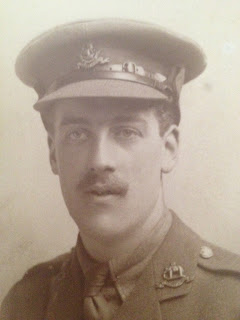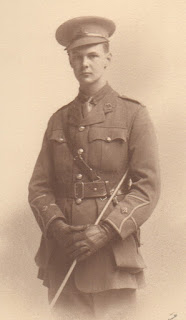A fine day. There was heavy German shelling of reserve
positions and intensive shelling of British front line around dawn.
Overnight 1st/2nd the Battalion relieved 8Yorks in the front
line on the right sector of the Divisional Front. One Company remained at the Caterpillar
(I.35.a.9.2) and three Companies were positioned on the eastern edge of Battle
Wood between O.6.a.2.5 and I.36.b.2.3; Battalion HQ was located at
I.35.a.35.20. The line in this sector was by no means continuous or secure and
was actually held by a series of posts.
Three officers serving with the Battalion were promoted
Lieutenant. Capt. Bob Perks DSO (see 28th June) was already holding
his more senior rank in an acting capacity whilst commanding a Company; 2Lt. David Lewis Evans (see 15th June) and 2Lt. Herbert Sparling (see 15th
June) were also promoted.
 |
Capt. Bob Perks DSO
Image by kind permission of Janet Hudson
|
2Lts. Conrad Anderson
(see 20th June) and Ronald Ferguson (see 20th June), who had arrived in France ten days
previously, reported for duty with 10DWR.
There were also promotions for a number of former officers
of 10DWR who were now in England, having been wounded or taken ill on active
service. 2Lt. Frederick Lowther Dawson
Barker (see 22nd September
1916), who had been taken ill in September 1916; 2Lt. Harry Foster (see 8th
July 1916), who had been in England since suffering shellshock on the Somme
in July 1916; 2Lt. Ernest Cyril Coke
(see 11th January), who
had been wounded on the Somme in July 1916 and was now serving with 3DWR at
North Shields; and 2Lts. Stanley Currington
(see 4th October 1916) and
John Keighley Snowden (see 28th June), both of whom
had been wounded at Le Sars in October 1916, were all promoted Lieutenant. 2Lt.
George Stuart Hulburd (see 7th April), who had been
taken ill in April, and 2Lt. John Redington
(see 10th April), who had
been taken ill in July 1916 and was now employed at the Army Recruiting Office
in Wolverhampton, were also both promoted Lieutenant.
 |
Lt. George Stuart Hulburd
Image by kind permission of Paddy Ireland
|
Cpl. Arthur Edward Hunt (see 27th November 1916), serving at VI Corps HQ, was awarded Class I Proficiency Pay.
For the second time in less than a month Pte. Albert Saville (see 7th June) was reported absent without leave from 298th Labour Company, based at Ripon. On this occasion he was apprehended, on the same evening, by a member of the Military Police. On returning he was confined to barracks for three days.
Trooper Claude Darwin
(see 9th June),
serving in Egypt with 1st Field Squadron, Engineers, Anzac Mounted
Division, who had been in hospital for the previous two weeks suffering from an
abcess to his neck, was transferred to the Citadel General Hospital in Cairo.
He was the brother of Tunstill recruit, Pte. Tom Darwin (see 26th
June), who had recently been evacuated to England having been wounded on 7th
June
Following the death of James
Hatton Kershaw (see 13th
June) there was a review of his pension arrangements. Henceforth the
pension was to payable at the ‘motherless rate’ of 14s. per week in respect of
his two sons. 7s. per week was to be payable to the paternal grandmother, Eliza
Kershaw as guardian of the elder son, William Riley Kershaw, aged seven, and
7s. per week to the maternal grandfather, Arthur Wilson, as guardian of the
younger son, Stanley Lister Wilson Kershaw, aged three.
Monday 2nd July
Front line trenches in Battle Wood; one company at the
Caterpillar (I.35.a.9.2) and three Companies between O.6.a.2.5 and I.36.b.2.3.
Another fine and hot day. The front line was very heavily
shelled around dawn.
Pte. Albert Edward
Ford was buried by a shell explosion; I am unable to establish the details
of his medical treatment. He was 21 years old and had enlisted in August 1915;
he had originally served with 9DWR and had suffered wounds to his left arm in
August 1916. The date and details of his transfer to 10DWR are unknown.
 |
Pte. Albert Edward Ford (standing, left)
Image by kind permission of Kirstie Ford
|
L.Cpl. Thomas Riding (see
25th June) and Ptes. Albert
Nixon (see 3rd May 1916)
and Fred Teal (see 5th December 1916) departed for England on
ten days’ leave.
Pte. James Arthur
Markinson (see 7th June)
was admitted, via 5th London Ambulance, to 23rd
Divisional Rest Station for treatment for inflammation (‘ICT’) in his left
hand.
Ptes. Ernest Ashness
(see 25th June) and Herbert Willoughby (see 25th June) were
discharged from 23rd Division Rest Station and returned to duty.
Cpl. Thomas Arthur
Sturdy (see 6th June),
who had suffered severe wounds to his left leg on 6th June, was
evacuated to England for further treatment. Pte. Fred Mitchell (see 8th
June), who had had his right leg amputated having been wounded on 8th
June, was also evacuated to England.
Cpl. Billy Rawlinson
(see 12th June), who had
been severely wounded at Contalmaison, was formally discharged from the Army,
with the award of the Silver War Badge. His character reference on discharge
described him as, “A steady, willing, intelligent and reliable man; has been a
non-commissioned officer for over two years and served 11 months at the front
where he gave satisfaction. Received multiple wounds in action”.
A payment of £20 4s. 7d. was authorised, being the amount
due in pay and allowances to the late Acting CQMS Thomas Doyne (see 17th
February); the payment would go to his daughter and sole legatee, Eileen.
His widow, Bridget, was an inmate at Richmond Asylum, Dublin.
No comments:
Post a Comment